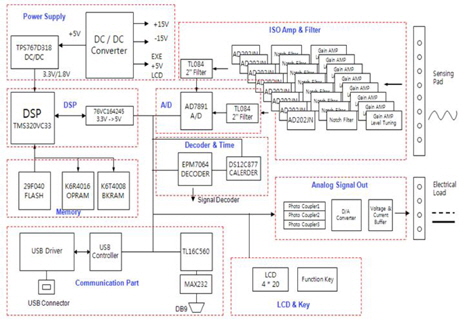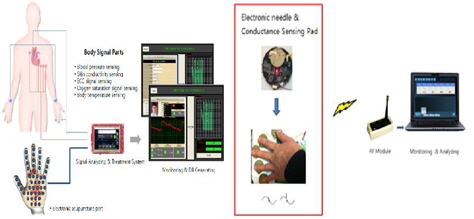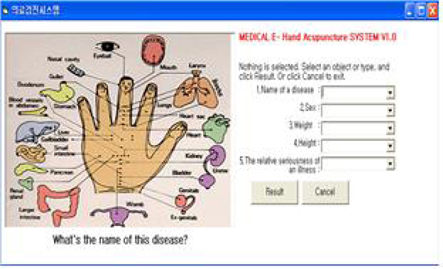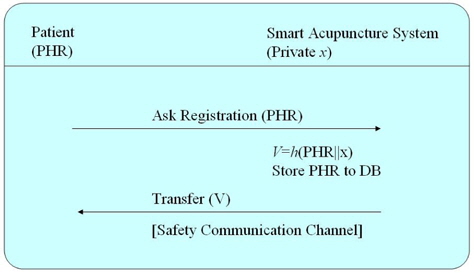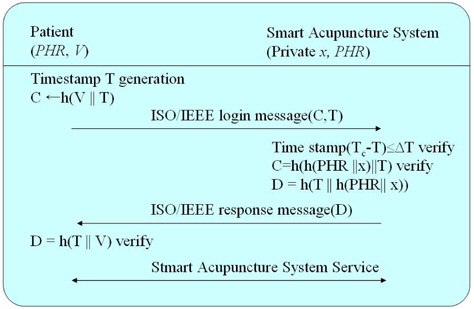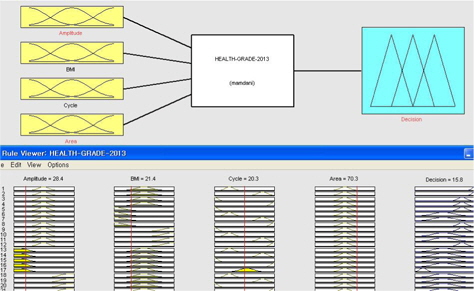



This paper proposes a traditional-style electronic acupuncture system for telemedicine, together with an encryption method for securing patients’ data. The provision of a medical service in dangerous or remote situations, such as on battle fields, would be possible if the pulse signal of patients could be transmitted to doctors based remotely with as little distortion as possible. In this regard, an Internet-based remote transmission system was implemented to conduct noise reduction research. The use of such a system requires the ability to accurately perform a diagnosis using pulse data, and to understand changes in the skin conductivity across the different areas of the body [1-4].
This paper proposes an electronic mechanism for the accurate measurement of pulse data and skin conductivity by objectively measuring physical conditions such as patients’ body type, skin impedance, and blood vessel compliance based on fuzzy rules and body context algorithms. Body areas presenting a negative diagnosis are treated by applying electronic stimuli upon which the returned signal patterns are measured for determining the patient’s conductivity characteristics [5-7]. Damaged bodily functions and reduced muscle performance impede blood circulation and lead to a corresponding reduction in oxygen and nutrition supply. Restricted circulation results in the accumulation of bodily waste that is not excreted [8-10].
These symptoms are the main cause of muscle pain. Areas presenting acne, atopic dermatitis, and age spots have a high electrical resistance as they behave similar to insulators. A low oxygen supply and a disruption of the balance in the skin tissue could give rise to inflammation of the skin caused by dead tissue, which would in turn result in atopic dermatitis and age spots. Previous studies attempting to use pulse data for diagnostic purposes were unable to transfer data of this nature electrically as it is influenced by characteristics such as the condition of a patient’s skin tissue, and age and gender-related diseases, all of which complicate the location of the exact point for acupuncture treatment as well as the determination of the duration and strength of the treatment. For these reasons it is particularly challenging to treat elderly people and children for whom damaged or bruised skin tissue is often reported after electronic acupuncture treatment.
This paper proposes the intelligent fuzzy methods [11-13] in an attempt to address the problems described above. The method adjusts the duration and intensity of the electronic acupuncture according to the requirements of each individual patient. Moreover, the new method uses a glove-type device to provide multiple stimuli of varying intensities to those areas of the body that require treatment.
2. Electronic Acupuncture Systems Using Security Functions
This paper presents an electronic stimulus system for treatment via the palm of the hand. The system recognizes registered users and retrieves their medical data, before applying the appropriate stimuli. The system improves the reliability of users’ pulse signal by first applying a reference signal to the palm area, after which the response signals are measured using the sensing pads located at the fingertips. Both signals are subsequently compared at MCU with information that was obtained during previous examinations as the physical conditions of the patient are known to the system. The information is processed using the fuzzy algorithm of the system and used to determine customized treatment methods. Following this, adjusted stimulus signals are sent to the sensing pad. Though there are some variations, care has to be taken to ensure that the current does not exceed levels between 16 mA and 50 mA, which the human body would be unable to tolerate as it would cause an irregular heartbeat that could endanger human life. Figure 1 shows the flowchart of the electronic acupuncture system.
The skin impedance of the patient is measured at different temperature and humidity levels by applying an intermittent electronic stimulus in the form of a pulse signal with a DC voltage between DC 50 V and 200 V, a current between 500
Figure 2 shows the electronic acupuncture system that uses WiBro-based Internet access instead of an RS232C serial connection to obtain the measured pulse signals. After a treatment session, the 28 pulse-signal graphs, intensities and periods are easily saved. A possible signal interference in the form of an electric shock to the computer through the cable can be prevented by changing the connection method from wired to wireless.
Figure 3 shows the interface of a globe-type electronic acupuncture system. The near future will see the development of a mobile phone-based electronic acupuncture system that will have the ability to save blood pressure measurements, an electrocardiogram as well as pulse data to an electronic medical record (EMR) chart. Globe-type electronic acupuncture systems are currently being simulated in preparation for these developments. Many current research efforts are being directed at applying scientific research methodology to traditional medical treatments. This includes combining traditional oriental medical systems with western medical systems and using them cooperatively to advance medical knowledge. This paper proposes a new way of collaboration by applying a secure web-based wireless connection to enable remote diagnosis based on remote access to patients’ data, which is protected using cryptography technology. For this purpose secret keys and a personal health record (PHR) are used to protect patients’ pulse data using a secure image steganography method that offers efficiency and an enhanced level of security. The algorithm utilizes the LSB algorithm to hide a patient’s PHR in a medical image with a secret key. The image steganography technology for pulse data comprises two steps: encoding and decoding.
Assuming the sender and the receiver share a secret key
1) The sender receives image i with pulse data from the electronic acupuncture system database to send to the receiver in a secure way. 2) The sender uses the shared secret key to apply the LSB based steganography algorithm to the pulse signal graph image i, upon which the secured pulse signal image Ci is generated and sent to the receiver through public channels.
The decoding phase works as follows: after the receiver receives the PHR
2.3 Mutual Authentication Scheme
The lightweight mutual authentication scheme is composed of two phases: registration and authentication.
First, the assumption is made that
1) Calculate the secret information V=h(PHR||x), where h() denotes a secure one-way hash function such as SHA-256, and ||denotes a concatenation operation. 2) Save PHR to the secure databases. 3) Send (V) to the patient through a secure communication channel.
2.5 Mutual Authentication Phase
Figure 5 shows the process of the mutual authentication phase. The patient with a
1) Generate the current authentication request time stamp information T. 2) Calculate the encryption message C=h(V||T). 3) Send the ISO/IEEE access and authentication request message (C,T) to a SEAS.
After the SEAS receives the authentication request message (C,T), it executes the following steps to finish the authentication process.
4) The validity of the received time stamp T is verified by the condition:
Tc − T ≤ ΔT,
where Tc is the received time stamp information from the SEAS, and ΔT is a legitimate time interval including transmission delay. If the above condition is not met, the SEAS denies the authentication request.
5) Final authentication is decided using Eq. (1).
If Eq. (1) is not correct, the SEAS denies the patient’s authentication request; however, if the validation process passes without problems, the system considers the request to be from a legitimate patient and replies with an ISO/IEEE access response message. Authentication request trials that fail more than three times to automatically lock the patient’s account by the system, which can be reactivated once the patient requests it to be unlocked by providing the required proof.
6) After the patient is successfully authenticated, the SEAS calculates the encrypted message for mutual authentication D = h(T||h(PHR||x)), which it sends to the patient as an ISO/IEEE response message.7) Once the patient receives the mutual authentication message (D), the patient checks Eq. (2) to decide whether the mutual authentication can be accepted or not.
If the result of Eq. (2) is correct, the patient is able to confirm mutual authentication to the system, whereupon both the patient and the system execute measurements, which are then transmitted and collected safely.
8) The receiver can extract the PHR and the original pulse signal diagram image i securely from the pulse signal diagram image Ci (that was created using steganography) by using the LSB based steganography algorithm and the shared secret key x. Since the patient’s PHR can be accessed once the recovered pulse-signal diagram image I has been authenticated, the proposed steganography methods provide a high level of security.
(1) The software that automatically saves the medical data has been simulated for traditional medical devices such as those performing tongue or pulse diagnosis. (2) The web-based SEAS (SW + HW) is implemented and can easily be used for remote diagnosis without limitations in terms of time, location, or user. (3) Upon transfer of the patient’s medical data to the hospital via the internet, the medical record (JPG, BMP) files are prone to tampering or interception, a vulnerability that can be overcome by using the proposed encryption method. (4) The electronic acupuncture system + EMR SW + HW uses simulation and measures the skin impedance to automatically search for a suitable area to which the treatment can be applied. Figure 6 shows example of graphic illustration of the process used for a patient’s EMR data encryption. (5) Existing electronic acupuncture systems have dif-ficulty to simultaneously locate multiple spots for treatment. Therefore, this study proposes an effi-cient SW that uses parallel electronic acupuncture stimulation capable of locating multiple spots for treatment.
Even though the frequency and amplitude of the pulse wave are the most important factors, the waveform state varies for the same patient, depending on the patient’s mood, on whether the measurement is taken before or after a meal, and on the time of day (morning, afternoon, or evening). Moreover, the frequency and amplitude of the pulse wave is influenced by other factors such as drinking a cup of coffee, or feelings of anxiety or fear. In addition, the psychological state of the patient and all other physical conditions are not always constant. Therefore, in this research the patient’s gender, age, and physical condition were considered together with the degree of confidence about the disease, and our new algorithm is based on those considerations.
First, knowledge of the conditional probability P (Hi |E) is required to know the prior probability P (Hj), and the conditional probability P (E |Hj). For example, in the body of the patient the symptoms of the disease, Hi, can be deduced if E represents the symptoms of each disease. However, this data would be insufficient to obtain a realistic value for the probability P (E |Hj). Therefore, in this research, fuzzy rules were used to calculate confidence values based on the understanding of the disease. This was done as follows:
IF E1 AND E2 AND E3 THEN H CF (H, E) = CF (H, E1 ∧ E2 ∧ E3) = 0.8 MB (E1, e) = 0.6, MD (E1, e) = 0, CF (E1, e) = 0.6 MB (E2, e) = 0.3, MD (E2, e) = 0, CF (E2, e) = 0.3 MB (E3, e) = 0.5, MD (E3, e) = 0, CF (E3, e) = 0.5 When it is called, CF (E, e) = CF (E1 ∧ E2 ∧ E3, e) = MB (E1 ∧ E2 ∧ E3, e) - MD (E1 ∧ E ∧ E3, e) = Min (MB (E1, e), MB (E2, e), MB (E3, e)) - Max (MD (E1, e), MD (E2, e), MD (E3, e)) Min [0.5, 0.6, 0.3] -0 CF (H, e) = CF (E, e) CF (H, E) = 0.3 0.7 = 0.21
Rule: IF A is t1 THEN C is B2 (Fu) fact: A is t1 ’(Fr) conclusion: C is t2 ’ (FC) A: clinical patient status C: inference results Fu: rules of the fuzzy number that represents the uncertainty Fr: the fact that is the uncertainty of the fuzzy number FC: conclusion of the fuzzy number that represents the uncertainty V1, V2, V1 ’, V2’: value (values) where the conviction rate (CF) represents as, Fr as a measure indicates the possible
RULE IF P amp = Low And BMI = High And P_cycle = High And Tongue coating area= Med And Then Strongwave = CNF 70
This can be explained as follows: This RULE indicates the degree of confidence to be 70%. Without the use of fuzzy rules, existing methods do not display the degree of confidence in these patients; hence, it is likely to always be classified as a strong wave, assuming a degree of confidence of 100%. For the purposes of this simulation, body mass index (BMI, weight [kg] / height [m2]), rate of the pulse waveform (P_rate), amplitude of the pulse wave form (P_amp), and the Tongue coating area were taken into account. If the patient presents a low degree of confidence in their pulse wave form (P_amp = Low), then it is concluded that the degree of confidence that is required is 80%, which means that 0.8 × 0.7 = 0.56. However, values such as this are difficult to determine with any precision, because the disease may have caused the patient to become exhausted, thereby influencing their pulse strength and rate, and hence, their gender or age-related pulse wave form. Variations in the pulse wave form could also result from other physical conditions.
Fuzzy IF-THEN rules are typically represented in the form of fuzzy reasoning (fuzzy inference) to determine which new relationships can be inferred from a given rule or set of processes. For this purpose max-min inference was used.
Input: x is A ’AND y is B’ R1: IF x is A1 AND y is B1, THEN z is C1 OR R2: IF x is A2 AND y is B2, THEN z is C2 ..... ....... ........ OR Rn: IF x is An AND y is Bn, THEN z is Cn
Figure 7 shows the fuzzy production rules in which two or more different conclusions will both have a credible value. In this case, the credible conclusion, which is used to re-calculate the value function, is a function of the combined credible values. For example, although some patients have experienced aortic regurgitation, their aortic membrane would be considered normal, if the probability that the probability of 0.3 is 0.7. However, in this ambiguous situation, it would not be possible to judge whether the fuzzy measure of the probability of aortic regurgitation ‘risk’, as suggested by the 0.3 and 0.7 probability, confirms normal aortic membrane function. This situation arises because the physical condition of the patient, the patient’s health condition, and other factors such as the presence of other diseases are only some of the many variables that could exist. A fuzzy set is defined by defining the fuzzy set of fuzzy values associated with all of the elements that belong to a set of values. Thus, in fuzzy sets there are degrees of belonging (or membership), with the respective values of fuzzy sets ranging from 0% (or 0) to 100% (or 1). This contrasts with the concept of an exact value, where only one of the values in a range is correct and all the other values are incorrect. In fuzzy sets and fuzzy values, each of the probabilities in the range from 0% to 100% represents the truth.
Oriental doctors should not only judge the basic biological signals such as checking the pulse’s size, strength, and rate, but should also consider a basic and quantitative analysis of the pulse in order to make an accurate diagnosis. In addition, the doctor should consider physical characteristics, such as the thickness of the skin and blood vessels, to reach an accurate conclusion. Therefore, measurement of the blood flow rate is a vital indicator for understanding the blood pressure rate and the methods by which substances are transported in the blood. Existing diagnostic methods are problematic in that they cannot be used to obtain an exact diagnosis of the old and the infirm, because these methods do not take into consideration the patient’s age or gender, or the condition of their skin. This problem was solved by analyzing the fine distinction between variations in the thickness of the skin, blood vessels, and the pulse, to assess their condition in terms of size, strength, and rate. As shown in Figure 8, the proposed algorithm enables an optimal patient diagnosis that considers the patient’s condition by using an intelligent fuzzy technique.
In future, hospitals are expected to automatically issue transcriptions and perform remote diagnosis, which means that patients’ data are important and need to be protected. Patients’ transcription data could be compromised as a result of unauthorized access, possibly with lethal results. Hence, personal and sensitive data stored on telemedicine and medical information systems should be encrypted and require the use of login passwords, and personal identification and biological information should similarly be protected in a systematic way. This paper proposes a system based on electronic acupuncture with a built in multi-pad. The advantage of this system is that it has the ability to determine a patient’s physical condition, while simultaneously treating the patient with acupuncture. The system implements a sensing pad, AMP, a small signal drive circuit, and a digital signal processing system and performs analyses by using the proposed built-in fuzzy technique together with a control algorithm. Traditional medical systems consider the pulse rhythm to be important, the reason why it is observed carefully during health checks and diagnoses of diseases. In contrast, this research utilized fuzzy logic and a fuzzy inference rule to estimate the proper treatment duration for each patient. Patients’ physical condition, related diseases, and age-related effects are all assessed using electronic acupuncture. The simulation results showed that the proposed method is more efficient than existing methods.
